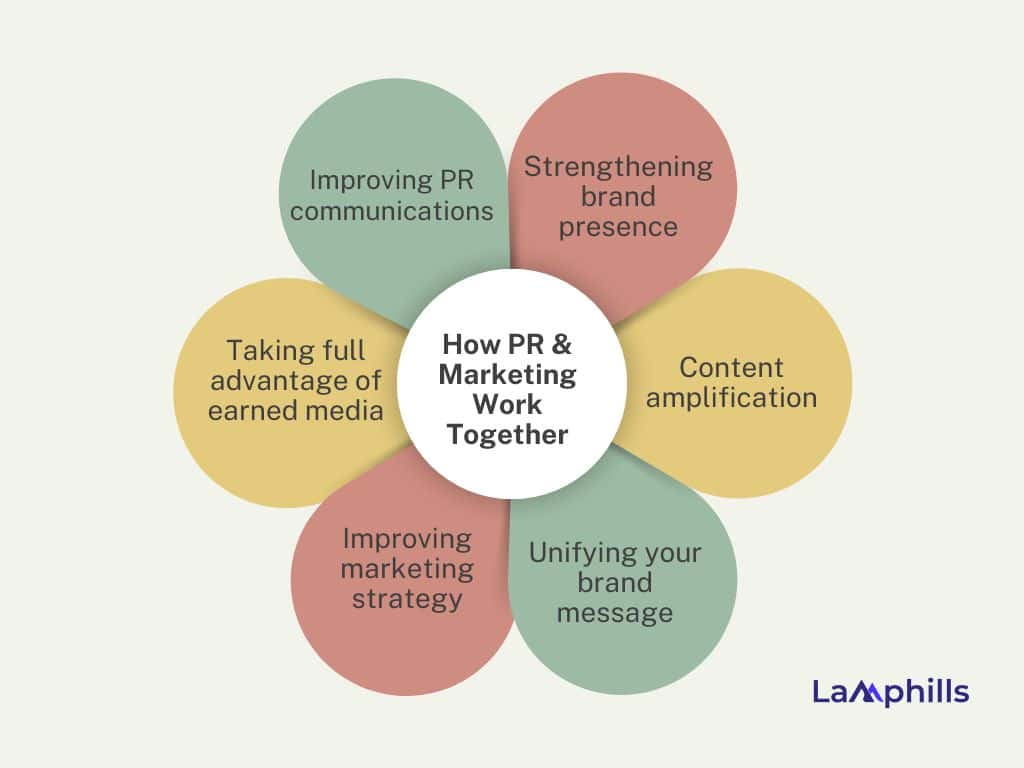Years after getting into the public relations space, I still get a few funny looks when I tell people what I do for a living. I understand, though; if marketing were to be a pie, then PR is but a nuanced slice – a crust, even.
Most people just aren’t aware of the subtle impacts that a good PR and communications plan can have on the general public.
Historically, PR and marketing departments in large companies have worked as distinct entities. PR has focused on communicating with the public and maintaining the company’s trust, reputation, and public perception. Marketing, on the other hand, has primarily focused on brand building, product promotion, and boosting sales.
Key Points
- Public relations in marketing is a company’s use of tactics and strategies that generate brand equity, build a positive image, highlight product and service launches and updates, and ultimately boost sales and revenue.
- Public relations is a subset of marketing that focuses on earned media management.
- PR strategies are similar to marketing strategies because the primary goal is to spread brand awareness.
- Public relations in marketing combines both PR and marketing to create and share compelling stories, build relationships with your target audiences, and achieve your business goals.
- PR and marketing can work together to strengthen your brand presence, unify your brand message and improve your marketing strategy.
What Is PR Marketing?
Public relations in marketing is a company’s use of tactics and strategies that generate brand equity, build a positive image, highlight product and service launches and updates, and ultimately boost sales and revenue.
Let’s take a closer look at these terms individually.
Public relations is defined as the process of establishing strategic communication relationships across different media channels to promote the positive perception of your company with the relevant audiences and get additional coverage from those channels.
An established PR strategy defines every way in which a company positions itself on the global stage and communicates with all the stakeholders. These are your current and prospective customers, journalists, influencers, and anyone else who’s important to your organization. These help a company organize its public relations efforts to attract its target audience and identify ways to reach its goals during the planning stage.
They’re similar to marketing strategies because the primary goal is to spread brand awareness.
PR professionals earn media coverage by:
- Building relationships with journalists and members of the media
- Responding to requests for information
- Writing and distributing press releases
- Creating and implementing social media strategies
- Monitoring brand mentions and crafting responses
- Managing crises and negative attention
- Evaluating and leveraging promotional opportunities
- Organizing and attending events
Public relations is a subset of marketing that focuses on earned media management. As a broader category, marketing includes:
- Earned media
- Paid media, like search engine marketing (SEM)
- Owned media, like your website or blog
- Email marketing
- Content marketing
Public relations in marketing combines these two important business functions to create and share compelling stories, build relationships with your target audiences, and achieve your business goals.
Types of Public Relations
While marketing focuses on promoting products and services, the true meaning of public relations lies in reputation management. Numerous areas of public relations ladder up to this goal, which include:
Media Relations
Media relations is a big part of what PR professionals do. It involves developing relationships with contacts at media outlets who can get your message out to the public. They do this by creating compelling press releases and targeting them to the right journalists. It’s mutually beneficial: Journalists get information from experts about stories that are important to them, and businesses get positive media coverage.

Influencers are also a key part of a modern media relations strategy. In fact, our 2023 Global Comms Report showed that 43% of communications professionals are relying on influencers more than they did last year – behind only paid and earned social media.
Community Relations
Positive media relationships can help your business be perceived well by the general public, but it’s also important to make sure you’re reaching the local community – after all, you’re a part of it. Volunteering, donating, and sponsoring local events can all help your company get involved and ensure you have a positive impact on the community. It’s also an important way to communicate your values to your stakeholders and the broader public.
Corporate Communications
Corporate communications is the process of communicating within your organization and with other businesses in your industry. It includes things like internal and external emails, newsletters, memos, speeches from executives, employee handbooks, and other resources. It sets the tone for all your communications.
Employee Relations
When you’re learning how to do digital PR, it’s easy to fall into the novice error and focus on the clients and the clients alone. In reality, public relations are much more complicated than that. For starters, you need to make sure that your PR plan never omits your own employees, both current and potential ones.
Think of it as internal PR.
First of all, your very own staff might be the strongest team of brand ambassadors you’ll ever need. At the same time, an unhappy employee is very likely to spread the harshest criticism. That’s why companies must invest in employer branding and internal PR & communications to ensure your team members feel appreciated, heard, and respected.
Employee Relations
When you’re learning how to do digital PR, it’s easy to fall into the novice error and focus on the clients and the clients alone. In reality, public relations are much more complicated than that. For starters, you need to make sure that your PR plan never omits your own employees, both current and potential ones.
Think of it as internal PR.
First of all, your very own staff might be the strongest team of brand ambassadors you’ll ever need. At the same time, an unhappy employee is very likely to spread the harshest criticism. That’s why companies must invest in employer branding and internal PR & communications to ensure your team members feel appreciated, heard, and respected.
Crisis Management
While negative press certainly isn’t new, even the smallest mistake today can quickly go viral – and big mistakes can take down a business. Events like Southwest Airlines’ holiday flight meltdown, Starbucks’ illegal union-busting, and the entire FIFA World Cup in Qatar are just a few examples of public relations crises.
PR professionals are at the front lines of crisis communications and crisis management, monitoring and responding to social media comments and crafting responses from the C-suite. They also leverage their media relationships to amplify their responses and turn the negative into a positive.
How Marketing and PR Work Together to Build Brands
PR and marketing each have their own approach, but they are similar at their core. Both help build brands and communicate with target audiences. They both have the objective of developing and maintaining a positive relationship with the public (consumers) through communication to meet a company’s goal.
Integrating marketing and PR strategy and tactics into an overall plan to increase your brand’s visibility and reputation can yield impressive results.
How Marketing and PR Work Together to Build Brands
How PR & Marketing Work Together To Drive Success
Here are some ideas on how PR and marketing can collaborate for more effective campaigns:

#1. Strengthening your brand presence
A strong brand presence is an asset from both a PR and marketing point of view. It also relies on good communication, which is one of the similarities between marketing and PR. Therefore, bringing your marketing and PR teams together can result in better brand collateral, such as brand colors, slogans and taglines, and audience approach. This, in turn, leads to a more robust and consistent brand presence.
For instance, let’s say you want to choose and register a domain name for your business. This is how the two departments would ideally work together. PR would help come up with a domain name that communicates the brand’s values, while marketing would give their insights to ensure the domain name makes sense from a marketing and SEO standpoint.
Even though domain name registrations typically cost only $10 – $15 annually, choosing the right one can have a massive impact on your brand.
#2. Content amplification
Marketing teams excel at brand storytelling—putting together great stories that influence your target audience and can increase your sales. The problem is, such stories, however perfectly crafted, mean little if they don’t get to the right people. This is where PR professionals come in.
PR professionals have good relationships with influencers, journalists, and other media contacts. Working together, PR teams can leverage these relationships to maximize the reach of your marketing team’s content and create more impact from your marketing campaigns.
Similarly, marketing teams can use their skills to support PR teams. For instance, if the PR team is preparing a product launch announcement, marketing can step in with product videos, infographics, and other such content to support the announcement.
#3. Unifying your brand message
The public relations department is usually tasked with creating a company’s brand values and messaging. Therefore, it’s a good idea for the marketing department to collaborate with PR when creating marketing content. The PR team can help the marketing team create content that’s more aligned with brand values and messaging and ensure that it maintains a consistent brand voice. Ultimately, this results in a strong and unified brand message.
Without such collaboration, it’s not surprising to see marketing teams creating content that isn’t aligned with brand values, which can dilute your brand message over time.
#4. Improving your marketing strategy
When marketers are tasked with constantly marketing the same product, it gets to a point where it becomes challenging to come up with new, creative ideas. Hiring a marketing agency to bring in new ideas is an option, but it can be quite costly—the average cost for an independent digital marketing manager is over $68,000 per year.
By collaborating with PR, however, marketers can get insights from customer information gathered by PR, such as client feedback and testimonials. They can then use these insights to develop new marketing ideas and strategies.
Additionally, collaboration with the PR team also creates opportunities for sharing more ideas.
#5. Taking full advantage of earned media
Earned media is vital for any business that wants to thrive in today’s highly connected world. According to Communique PR, 92% of consumers trust earned media, compared to just 50% who trust paid ads. In other words, consumers trust what other people say about your brand more than what you say.
Historically, PR has been responsible for keeping track of earned media. However, it shouldn’t stop here. By sharing information gained from social listening and media monitoring, such as audience sentiment and mentions, with marketing teams, PR can give marketers insights into the impact of marketing campaigns on consumers.
Marketers can then use this information to fine-tune marketing campaigns and achieve better success.
#6. Improving PR communications
A lot of times, PR professionals focus on facts. When releasing announcements and press releases, PR teams usually share articles and media pitches full of data. The problem, however, is that people rarely remember data, so such announcements aren’t as effective as they should be.
Marketers, however, understand that data doesn’t move people. Consumers care more about stories than data. When marketers collaborate with PR professionals when creating media statements and press releases, they can weave in brand stories and create more memorable and impactful announcements.
For instance, let’s say your business just made new changes aimed at ensuring PCI compliance with customers. Typically, PR would simply make a statement to communicate these changes and leave it at that. However, by involving marketing, you can create a more impactful story around your decision to make the changes and what this means for your customers.
By highlighting how being PCI compliant improves customer security and protects people’s sensitive data, you not only communicate the new changes but also get a chance to win new customers.
Examples of PR in Marketing
Within each type of public relations, various strategies overlap with marketing, including:
#1. Events
Events are often considered to be both public relations and marketing. PR and marketing professionals may attend events, host the booth and interact with potential customers. The overall goal is to maintain a positive relationship with the community and industry, but the desired outcomes are different.
Public relations will focus on promoting the brand as a whole and creating media buzz, while marketing will be interested in generating leads and making sales.
#2. Press Releases
Press releases are often thought of as the domain of public relations alone, and this is sometimes the case, especially when they’re used to announce events, changes in management, or other company news. However, they’re also a great example of public relations in marketing because they can have a huge effect on sales when they’re used to promote products or services.
A press release announcing a long-awaited product update or the launch of a new line of products can instantly boost demand.
#3. Blogs
On the other hand, blogs are often thought of as the domain of marketing alone. They’re a big part of a company’s search engine optimization (SEO) strategy and are often promoted on social media channels, which are both part of a good marketing strategy.
However, blogs also often address customer concerns, provide tips on how to use a product, showcase expertise, and share information about a company – all of which overlap with public relations.
#4. Social Media
Social media is a perfect example of both public relations and marketing because it is typically part of any successful communications strategy. Both your PR and marketing teams might create and publish social media posts, depending on the content. That would fall in the realm of your owned media.
The marketing team might run social media ads or influencer campaigns, which are paid media. The PR team might leverage social media monitoring so they can be aware of and respond to any important events, garnering earned media.
PR Marketing: In Conclusion
In recent times, the line between public relations and marketing has blurred, with both entities now collaborating on a brand messaging front. According to research, 90% of PR professionals believe that marketing and PR will become more closely aligned over the next five years.
This doesn’t mean that PR and marketing will merge into one. However, PR professionals and marketers must re-evaluate the relationship between the two industries and work together towards shared goals.
When it comes to a fully baked marketing plan, PR may be an afterthought because it takes constant attention and proofing to be effective. However, with the right pairing between agency and client, messages and storylines deemed mundane at first glance can take on a life of their own and benefit an organization’s reputation.
Integrating marketing and public relations can help brands strengthen their brand presence, amplify their content, unify the brand message, develop better marketing campaigns, take full advantage of earned media, and improve PR communications.
Recommended Articles
- How to Write a Good Restaurant Press Release (My Templates)
- SMART PR Goals: Examples & All You Need
- What a PR Strategist Really Does: (+ Free Helpful Tips)
- Bad PR Examples & Lessons You Should Learn (Expert Tips)
- PR Evaluation Reports: Key Metrics and Best Practices
- PR Tools: Our Best 15 Picks for 2024 (Free & Paid)






